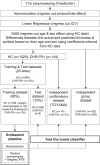Using brain structural neuroimaging measures to predict psychosis onset for individuals at clinical high-risk
- PMID: 38332374
- PMCID: PMC11189817
- DOI: 10.1038/s41380-024-02426-7
Using brain structural neuroimaging measures to predict psychosis onset for individuals at clinical high-risk
Abstract
Machine learning approaches using structural magnetic resonance imaging (sMRI) can be informative for disease classification, although their ability to predict psychosis is largely unknown. We created a model with individuals at CHR who developed psychosis later (CHR-PS+) from healthy controls (HCs) that can differentiate each other. We also evaluated whether we could distinguish CHR-PS+ individuals from those who did not develop psychosis later (CHR-PS-) and those with uncertain follow-up status (CHR-UNK). T1-weighted structural brain MRI scans from 1165 individuals at CHR (CHR-PS+, n = 144; CHR-PS-, n = 793; and CHR-UNK, n = 228), and 1029 HCs, were obtained from 21 sites. We used ComBat to harmonize measures of subcortical volume, cortical thickness and surface area data and corrected for non-linear effects of age and sex using a general additive model. CHR-PS+ (n = 120) and HC (n = 799) data from 20 sites served as a training dataset, which we used to build a classifier. The remaining samples were used external validation datasets to evaluate classifier performance (test, independent confirmatory, and independent group [CHR-PS- and CHR-UNK] datasets). The accuracy of the classifier on the training and independent confirmatory datasets was 85% and 73% respectively. Regional cortical surface area measures-including those from the right superior frontal, right superior temporal, and bilateral insular cortices strongly contributed to classifying CHR-PS+ from HC. CHR-PS- and CHR-UNK individuals were more likely to be classified as HC compared to CHR-PS+ (classification rate to HC: CHR-PS+, 30%; CHR-PS-, 73%; CHR-UNK, 80%). We used multisite sMRI to train a classifier to predict psychosis onset in CHR individuals, and it showed promise predicting CHR-PS+ in an independent sample. The results suggest that when considering adolescent brain development, baseline MRI scans for CHR individuals may be helpful to identify their prognosis. Future prospective studies are required about whether the classifier could be actually helpful in the clinical settings.
© 2024. The Author(s).
Conflict of interest statement
Author OAO conducted a consultant to cortechs.ai, received speaker’s honorarium from Lundbeck, Janssen, Sunovion. Author BYG has been the leader of a Lundbeck Foundation Centre of Excellence for Clinical Intervention and Neuropsychiatric Schizophrenia Research (CINS) (January 2009 – December 2021), which was partially financed by an independent grant from the Lundbeck Foundation based on international review and partially financed by the Mental Health Services in the Capital Region of Denmark, the University of Copenhagen, and other foundations. All grants are the property of the Mental Health Services in the Capital Region of Denmark and administrated by them. Other authors have no conflict of interest to declare that are relevant to the content of this article.
Figures




References
-
- Miller TJ, McGlashan TH, Rosen JL, Somjee L, Markovich PJ, Stein K, et al. Prospective diagnosis of the initial prodrome for schizophrenia based on the structured interview for prodromal syndromes: preliminary evidence of interrater reliability and predictive validity. Am J Psychiatry. 2002;159:863–5. doi: 10.1176/appi.ajp.159.5.863. - DOI - PubMed
-
- Catalan A, Salazar De Pablo G, Vaquerizo Serrano J, Mosillo P, Baldwin H, Fernández‐Rivas A, et al. Annual research review: prevention of psychosis in adolescents – systematic review and meta‐analysis of advances in detection, prognosis and intervention. J Child Psychol Psychiatry. 2021;62:657–73. doi: 10.1111/jcpp.13322. - DOI - PubMed

